Monday’s Mish-Mash: Ladies’ Undergarments: Bloomers, Pantaloons, or Drawers?
Women’s drawers have frequently been misidentified. All it takes is a quick search of eBay and you’ll find plenty of Victorian drawers that have been mislabeled. So, what’s the difference between bloomers, pantaloons, pantalets, and drawers? Let’s take a closer look and see what’s what.
Bloomers and Pantaloons
Some today refer to a lady’s drawers as “bloomers,” but bloomers weren’t undergarments. In the 1850s, Amelia Bloomer became infamous for wearing baggy trousers beneath her shortened skirts. At first, bloomers were outrageous and only worn by a few brave radicals. Several decades later, however, bloomers became popular as sportswear, worn for bicycling, gymnastics, and other outdoor activities.
Another common misnomer is “pantaloons,” but these were, in fact, a men’s garment. During the late 18th century, the fashion for knee-length breeches was supplanted by the newfangled pantaloons, which were snugger and longer, ending between mid-calf and ankle.
Pantalets
What about pantalets? They were, indeed, underwear. Unlike traditional drawers, however, pantalets were narrow and quite long. While only worn briefly by women during the first half of the 19th century, pantalets continued to be fashionable for children through much of the Victorian era. They were intended to peek out beneath a girl’s short skirts and therefore often had ruffles at the ankle.
Drawers
The precise history of drawers is rather spotty, with reliable information hard to come by. It appears that prior to the 15th century, drawers were considered a masculine garment and were, therefore, too scandalous for ladies to wear. Of course, that didn’t stop women from secretly borrowing their husbands’ drawers or creating their own, for warmth in the winter and protection while horseback riding. Eventually, drawers became commonplace, at least in some parts of Europe, during the late 1400s and 1500s. but then they vanished again.
For more information on the use of drawers during the Renaissance, visit: The Realm of Venus: Fashion & Style in Renaissance Italy.
When the Regency era dawned and sheer muslin dresses became all the rage, women realized the need for some kind of undergarment beneath their petticoats and chemises, both for warmth and modesty. Early drawers were simple: two separate legs that tied around the waist. Later, the legs were widened and gathered onto a yoke or waistband, creating a single garment.
During the Victorian era, drawers were cut full in the hips, with legs that were either straight or gathered onto bands just below the knee. For decoration, they might have rows of pintucks and lace, a bit of embroidery, or perhaps a short ruffle. Some had a yoke, to which the bulk of the drawers was gathered, while others used a narrow waistband. The waist fastened with drawstrings, buttons, or a combination of the two.
As the Edwardian era approached, drawers became shorter and fuller. In the 1890s, some drawers were indistinguishable from petticoats, unless you pulled the fabric aside to find the separate legs.
Until the early 20th century, drawers were traditionally open through the crotch. The Victorians believed it was more hygienic to have fresh air circulating the nether regions. You might think of this as shockingly immodest, but remember that drawers had plenty of fabric at the hips, as well as overlapping edges that kept things from showing. Plus, they were buried underneath at least two petticoats and a skirt.
All thoughts of hygiene and propriety aside, the split crotch was a matter of necessity. Drawers were one of the first garments put on, with a corset laced snugly over them. They couldn’t be pulled down, so if they were sewn closed, there would be no easy way for a lady to use the toilet.
Plenty of rumors circulate about why drawers eventually came to be sewn closed at the crotch. For instance, some say it’s because of cancan dancers, who sewed their drawers shut so they wouldn’t expose everything when they lifted their skirts onstage. Personally, I believe that once the corset became unfashionable, open crotches were no longer a necessity and therefore disappeared.
Eventually, drawers evolved, shortening into tap pants, an early form of what we now call panties.
Images of Extant Drawers
- 1850 Pantalets, Metropolitan Museum of Art
- 1880s Drawers, Metropolitan Museum of Art
- 1890s Drawers, Metropolitan Museum of Art
- 1910 Drawers, Metropolitan Museum of Art
- 1928 Drawers, Metropolitan Museum of Art
Recommended Reading
- The History of Underclothes
C. Willett Cunnington - Underwear: Fashion in Detail
Eleri Lynn - The Corset and Crinoline: An Illustrated History
W. B. Lord

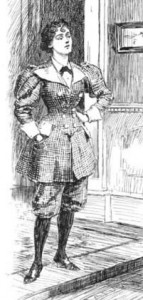
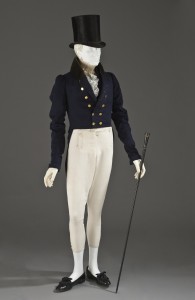
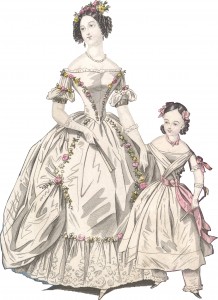
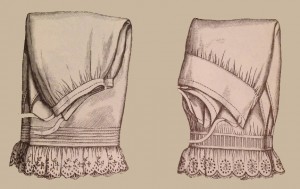
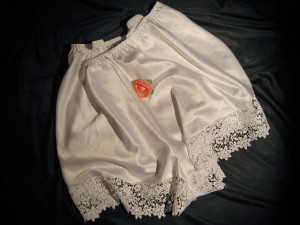
4 Responses to Ladies’ Undergarments: Bloomers, Pantaloons, or Drawers?